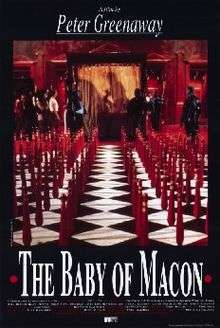The Baby of Mâcon
| The Baby of Mâcon | |
|---|---|
 Theatrical poster | |
| Directed by | Peter Greenaway |
| Produced by | Kees Kasander |
| Written by | Peter Greenaway |
| Starring |
Julia Ormond Ralph Fiennes Philip Stone Jonathan Lacey Don Henderson |
| Cinematography | Sacha Vierny |
| Edited by | Chris Wyatt |
Release dates |
|
Running time | 122 minutes |
| Country |
United Kingdom France Germany Belgium Netherlands |
| Language | English |
The Baby of Mâcon is a 1993 film written and directed by Peter Greenaway starring Ralph Fiennes, Julia Ormond and Philip Stone.
Plot
A town cursed with barren women and famine is saved by a miracle birth to an old, ugly woman: the Mother. Immediately afterwards, the old woman's Daughter (Ormond) claims to have delivered the baby herself in a virgin birth. She imprisons the Mother and begins to exploit the Baby by selling blessings to the desperate townspeople of Mâcon.
The Church is both suspicious and jealous. The Bishop's Son (Fiennes), a believer in science and a skeptic, doubts the Daughter. She attempts to convince him that she is indeed a virgin by offering her virginity to him. Before the Bishop's Son is able to consummate with the Daughter, the Baby commands a bull to kill him. The Bishop (Stone) arrives as his son has been gored, and blame for his son's death falls onto the Daughter.
The Bishop takes custody of the Baby and the Church begins exploiting him, and the town's faith, far more than the Daughter. In response, the Daughter quietly suffocates the Baby. The Bishop sentences her to death, but because she is still a virgin, she cannot be killed outright. The Daughter is instead sentenced to be raped 208 times, after which she is to be executed. But after the rapes she is found to be dead. The Church then dismembers the Baby's body and sells his remains as religious relics to the townspeople. Famine falls once again onto the city of Mâcon.
Cast
- Julia Ormond - The Daughter
- Ralph Fiennes - The Bishop's Son
- Philip Stone - The Bishop
- Jonathan Lacey - Cosimo Medici
- Don Henderson - The Father Confessor
- Celia Gregory - Mother Superior
- Jeff Nuttall - The Majordomo
- Jessica Hynes - The First Midwife (as Jessica Stevenson)
- Kathryn Hunter - The Second Midwife
- Frank Egerton - The Prompter
- Phelim McDermott - The First Tutor
- Tony Vogel - The Father
Interpretations
The Baby of Mâcon depicts the 1659 staging of a medieval morality play (invented by the filmmaker). Between the play's acts, the film also explores the "audience"—in a provincial Italian theatre at the height of the Counter-Reformation—and the "actors" backstage. Throughout, the viewer is reminded of the play's audience, and, at its conclusion, the on-stage actors bow to their (theatre) audience, who in turn bow to the modern (cinema) audience. However, all through this final denouement the corpses of the Bishop's Son and the Daughter remain motionless where they are displayed.
A member of the theatre audience, Prince Cosimo Medici, exists outside and inside the play, serving to blur the line between the narrative folds. The ten-minute rape sequence deliberately weaves through each cinematic narrative layer, further blurring the lines. In every narrative layer, exploitation and theatre recur, i.e. theatre's supporting power: in the play, ecclesiastical power; in the film, court power—each propels the narrative.
Reception
The film was screened out of competition at the 1993 Cannes Film Festival.[1]
References
- ↑ "Festival de Cannes: The Baby of Mâcon". festival-cannes.com. Retrieved 25 August 2009.